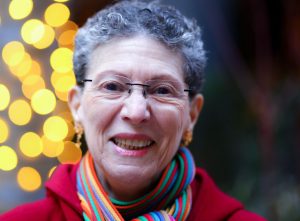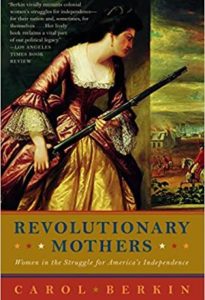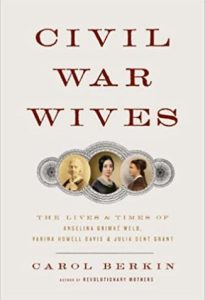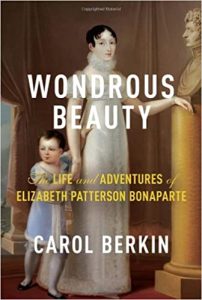Talking About Women’s History: Two Questions and an Answer with Carol Berkin
Carol Berkin is Presidential Professor of History, Emerita, of Baruch College & The Graduate Center, CUNY. She received her B.A. from Barnard College and her PhD from Columbia University where her dissertation received the Bancroft Award in 1972. She has written extensively on women’s history and on the American Revolution, the creation of the Constitution, and the politics of the early Republic. Her books include Jonathan Sewall: Odyssey of an American Loyalist [Columbia University Press] which was nominated for the Pulitzer Prize; co-editor of Women of America: A History [Houghton Mifflin & Company], the first published collection of original essays in American women’s history; First Generations: Women in Colonial America [Hill & Wang]; A Brilliant Solution: Inventing the American Constitution [Harcourt], awarded the Colonial Dames of America Book Prize; Revolutionary Mothers: Women in the Struggle for American Independence [Knopf]; Wondrous Beauty: The Life and Experiences of Elizabeth Patterson Bonaparte [Knopf] ; The Bill of Rights: The Struggle to Secure America’s Liberties [Simon and Schuster]; and most recently, A Sovereign People: The Crises of the 1790s and the Birth of American Nationalism. She has appeared in over a dozen documentaries on colonial, revolutionary, and civil war history, given lectures on her specialties at major universities in the United States and England, and participated in faculty development across the country under the U.S. Department of Education’s Teaching American History Grant Program. She has directed summer institutes for The Gilder Lehrman Institute of American History, Mount Vernon, and the NEH. She has served on the board of the National Council for History Education, the Staten Island Historical Society, and the Society of American Historians and on the Scholars Board of the New-York Historical Society’s Center for the Study of American women. She is a frequent participant in the New-York Historical Society’s lecture series, and is also the editor of the Gilder Lehrman online journal, History Now. Her favorite pastime is doting on her three grandchildren, Talulla, Noa, and Asher.
All I can say is, wow! Take it away, Carol!
You’ve written about a lot of interesting women. Do you have a favorite?
I am especially glad I had the chance to write about Elizabeth Patterson Bonaparte whose story I told in my book Wondrous Beauty: The Life and Adventures of Elizabeth Patterson Bonaparte. Elizabeth – or Betsy as she was called– was born in the late 18th century, the daughter of a wealthy Baltimore merchant, and she was by all accounts one of the most beautiful and brilliant women of her generation. She was restless and unhappy as a young woman, for she believed she belonged on a larger, less constricting and more sophisticated stage than the young republic had to offer a woman. She considered her native country a cultural backwater, its men consumed by money-making and its women content to live narrow lives as wives and mothers. She longed for the excitement and intellectual stimulation of European culture. Her discontent drove a wedge between her and her father whose rags to riches story left him obsessed with respectability and deeply socially conservative. At 17 Elizabeth’s wildest dreams came true: she met the youngest brother of Napoleon Bonaparte, an 18 year old naval officer who was visiting America. Jerome Bonaparte was, in fact, spoiled, selfish, and a womanizer but all she saw was his French manners and his charm—and her way to escape the mundane life of a genteel American woman. They married against her father’s wishes and, as they soon learned, against Napoleon’s as well. The emperor offered his brother an ultimatum: renounce this marriage, marry a member of the European nobility, and I will make you a king of one of the German territories I control , or, remain married to this commoner and I will disown you. Jerome Bonaparte chose option one, abandoning his young wife and her infant son without hesitation.
But this was far from the end of Betsy’s story. She pulled herself together, refused to ever depend on a man again, dared to take herself alone to Paris and London and later to Italy and Switzerland—breaking all the rules for well -behaved elite American women! Men fell in love with her by the dozens but she never considered marrying any of them. Instead, after becoming the belle of French literary salons—admired not only for her beauty and wit but her intelligence, she discovered to her delight that she did not need to bask in the light of a man; she could achieve her goals independently. Unfortunately, she focused most of her emotional energies on a long campaign to force the Bonaparte family to acknowledge her son and only child as a legitimate heir to the French imperial throne. For decades she pursued this dream, despite her son’s lukewarm response to her vision of a life among the royalty of Europe. In the end she failed, rejected by the Bonaparte heirs and, in her eyes, betrayed by her son who married an American heiress and settled contentedly into the bourgeois world of the US that she so despised.
Betsy’s only other consuming passion was financial independence and she proved to be a shrewd business woman and investor. She became the first self-made female millionaire of the 19th century, ironically engaging in exactly the money-grubbing she condemned in her father and American businessmen in general. In older age she returned to Baltimore, where she made clear her continued rejection of female domesticity; she refused to set up housekeeping in any of the properties she owned. She lived until her 90s in a rented room., surrounded by memorabilia and ball gowns from her days as the belle of Paris and Florence. She grew increasingly bitter and eccentric and could be seen, carrying her parasol and a large handbag as she went door-to-door collecting the rents from tenants in her many properties. Yet she retained her beauty and her wit. When she was 94 a local newspaper reporter visited her and wrote that she remained a “wondrous beauty.” She died soon afterward, refusing to be buried in the Patterson family cemetery. As she wrote: “I have lived alone and I will die alone.”
Many readers of my biography disliked Elizabeth Patterson Bonaparte. They consider her selfish and cold, and they see her life as a tragedy marked by her obsession with elevating her son to the throne. But I admired her. Imagine what it took to carve an independent path as a genteel woman in late 18th and pre-civil war America! She fulfilled her dreams, all on her own. She unleashed her intellectual talents, outdid her father and brother’s financial skills, traveled widely on her own when this was considered scandalous in America, and did not succumb to the many appeals by men to marry and be “taken care of.” She was witty, brilliant, and valued her mind over her looks. Her faults were many, but her strength of character allowed her to defy her moment in time and place and live as an individual rather than be defined by the female roles of her day. I say, Brava for her!
What do you find most challenging or most exciting about researching historical women?
There is such satisfaction to be able to look into the mirror of the past and see a female face. [<<Emphasis Pamela’s.] This is what the decades of women’s history since the 1970s has allowed me and sister colonial historians to do, and, I like to think, it has allowed young women of every generation since we began to reconstruct the American female past the same satisfaction. It was extremely challenging yet exciting in the early years; we were told we would not find any sources and, even if we uncovered some, they would tell us little about what was important about our 17th and 18th century beginnings. In fact, well -meaning male advisors urged us not to jeopardize our careers by diverting our attention to this irrelevant topic. To our delight we proved them wrong. Buried in the archives, under labels like “Miscellaneous Documents,” or in the papers of famous men as simply “Other material” were a treasure trove of diaries, letters, poems and accounts of white women’s lives during the centuries of settlement and Revolution that allowed the voices of women to be heard at last. Then, archeology and anthropology and computer skills began to let us write the stories of African American, Native American, and poor white women, few of whom left written records but whose collective portraits could at last be painted. Soon new ways of theorizing about women’s experiences and roles in their societies deepened our understanding. And a new interest in how men learn their gender roles grew out of our efforts to discover how female roles were inculcated and enforced. All of these developments were exciting. Slowly our profession has come to realize that old models of “what happened and why” had to be abandoned once women were seen as active agents in shaping our past. For example, my book, Revolutionary Mothers, joined earlier pioneer works in showing that the Revolution could not be adequately or accurately understood until women’s many roles in its unfolding were written into the narrative of the struggle for independence.
A question from Carol: In Alice Through the Looking Glass, the White Knight and Alice are living chess pieces on a chess board. Alice cannot understand why it is so hard to move across that board and win the game. The Knight explains to her that, sadly, in this world, you have to run twice as fast just to stay in the same place. What do you think can be done —or is being done —today to ensure that the fight for women’s equality will not be stuck running hard to stay in the same place?
That is the bazillion dollar question, isn’t it?
Ultimately, I think the answer is the same for women’s equality as it is for democracy in general: Don’t take what we have for granted. Don’t expect someone else to do the work.
Easy to type. Hard to do.
***
Come back tomorrow for three questions and an answer with cabaret performer Fiona-Jane Weston








